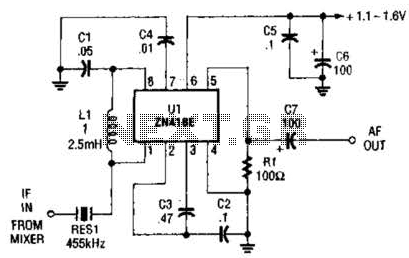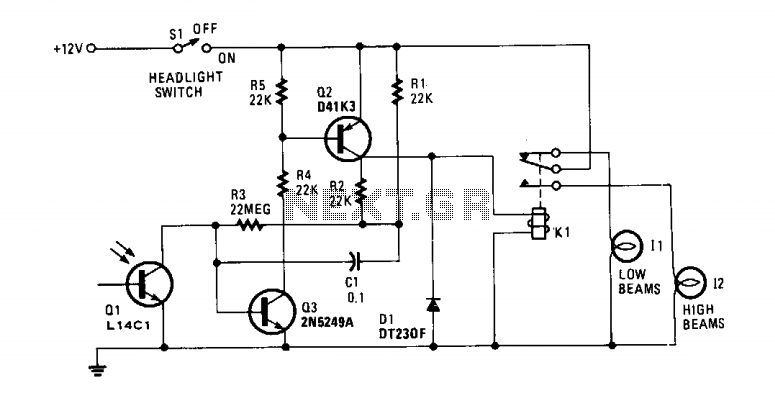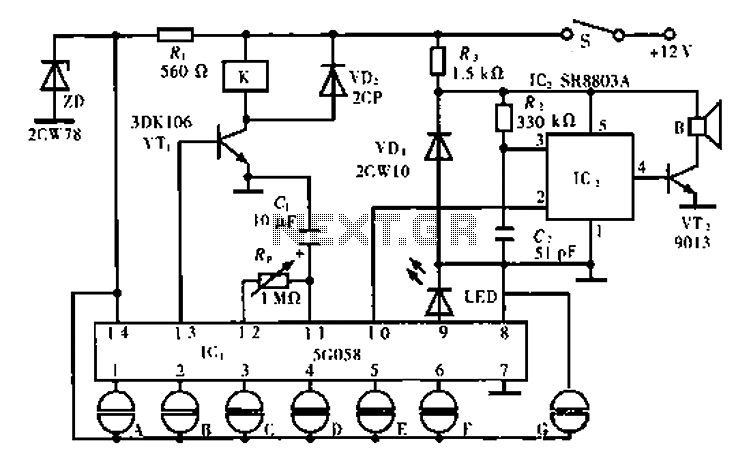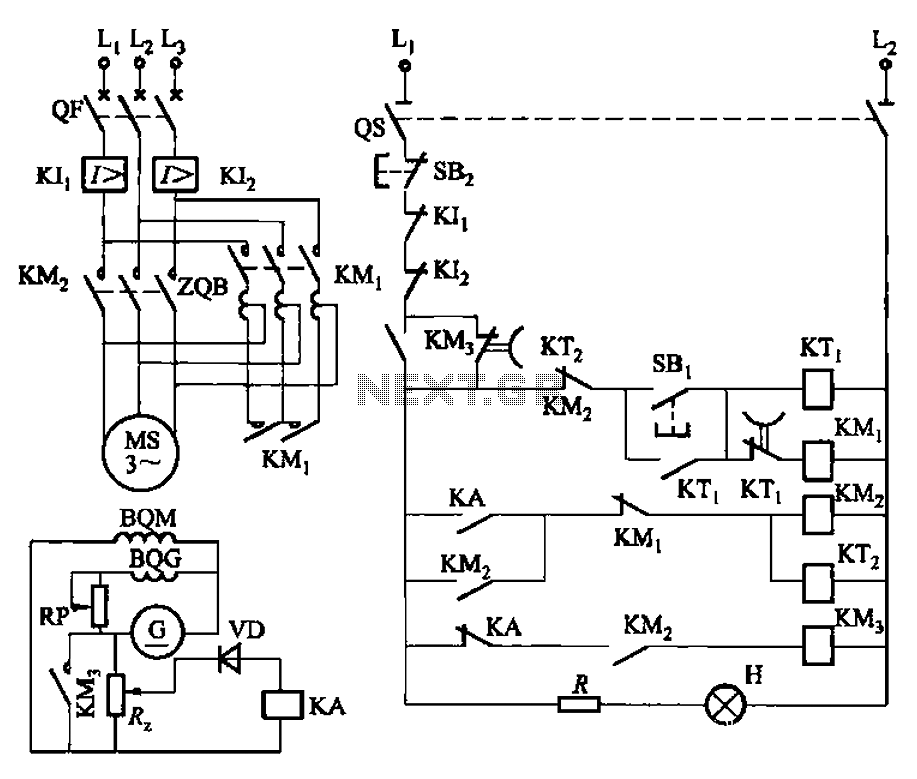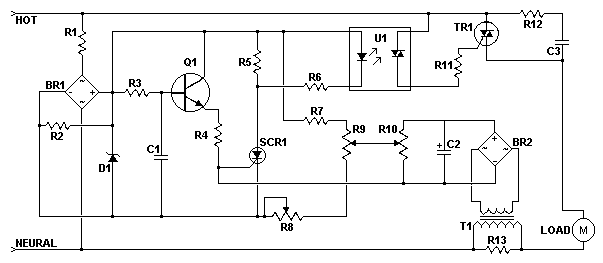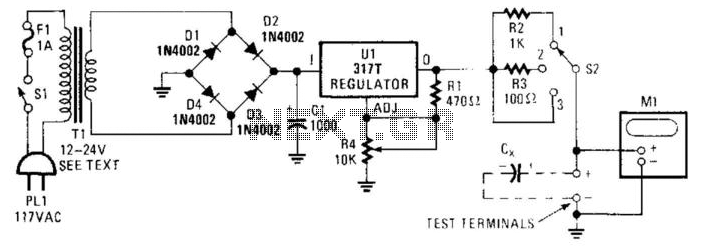
Ponyprog Circuit for ATMEL AVRs

The schematic includes programmable AVRs. For other members of the AVR family or additional programmable ICs compatible with Ponyprog, there is a J1 connector (CON10) that facilitates hardware expansion of the programmer. Additional information about compatible ICs can be found on Ponyprog's website. The JUMP1 jumper connects or disconnects the crystal circuitry to the 8-pin AVRs. Some AVRs feature an internal RC oscillator, making an external crystal unnecessary. For more details, refer to the JUMP1 table and the datasheet of the selected AVR. The JUMP2 jumper enables programming of devices from the AT89Sxxxx family or the AVR's AT90Sxxxx and ATmegaxxx families.
The schematic design highlights the integration of programmable AVR microcontrollers, which serve as the core of the circuit. The J1 connector (CON10) is a critical feature that allows users to expand the programming capabilities of the hardware to accommodate additional ICs beyond those explicitly depicted in the schematic. This flexibility is essential for developers who may want to utilize various microcontrollers from the AVR family or other compatible programmable devices.
The functionality of the JUMP1 jumper is significant in determining the operational mode of the circuit. By connecting or disconnecting the crystal circuitry to the 8-pin AVRs, users can select between using an external crystal oscillator or relying on the internal RC oscillator present in some AVR models. This choice is crucial for optimizing performance based on the specific requirements of the application. It is advisable to consult the JUMP1 configuration table and the datasheet for the specific AVR being used to ensure proper setup.
Furthermore, the JUMP2 jumper plays a vital role in extending the programming capabilities to include members of the AT89Sxxxx family and the AVR's AT90Sxxxx and ATmegaxxx families. This feature enhances the versatility of the programmer, allowing it to support a broader range of microcontrollers, which is particularly beneficial for developers working on diverse projects.
Overall, the schematic serves as a comprehensive guide for integrating and programming various AVR microcontrollers and compatible ICs, providing essential options for customization and flexibility in electronic design.On board the AVRs that can be programmed are those in the schematic. For other members of AVR family or the rest programmable ICs that Ponyprog can program, there is the J1 connector (CON10) which allows expanding the programmer`s hardware. See Ponyprog`s site for other`s ICs Ponyprog circuits. The JUMP1 jumper is there to connect the crystal`s circuitry to the 8- pin AVRs or to disconnect it. Some AVRs have internal RC oscillator and an external XTAL is not allowed or needed. Check the JUMP1`s table and the datasheet for the AVR of your choice for more details. The JUMP2 jumper is there to allow programming a member of the AT89Sxxxx family or the AVR`s AT90Sxxxx & ATmegaxxx family. 🔗 External reference
The schematic design highlights the integration of programmable AVR microcontrollers, which serve as the core of the circuit. The J1 connector (CON10) is a critical feature that allows users to expand the programming capabilities of the hardware to accommodate additional ICs beyond those explicitly depicted in the schematic. This flexibility is essential for developers who may want to utilize various microcontrollers from the AVR family or other compatible programmable devices.
The functionality of the JUMP1 jumper is significant in determining the operational mode of the circuit. By connecting or disconnecting the crystal circuitry to the 8-pin AVRs, users can select between using an external crystal oscillator or relying on the internal RC oscillator present in some AVR models. This choice is crucial for optimizing performance based on the specific requirements of the application. It is advisable to consult the JUMP1 configuration table and the datasheet for the specific AVR being used to ensure proper setup.
Furthermore, the JUMP2 jumper plays a vital role in extending the programming capabilities to include members of the AT89Sxxxx family and the AVR's AT90Sxxxx and ATmegaxxx families. This feature enhances the versatility of the programmer, allowing it to support a broader range of microcontrollers, which is particularly beneficial for developers working on diverse projects.
Overall, the schematic serves as a comprehensive guide for integrating and programming various AVR microcontrollers and compatible ICs, providing essential options for customization and flexibility in electronic design.On board the AVRs that can be programmed are those in the schematic. For other members of AVR family or the rest programmable ICs that Ponyprog can program, there is the J1 connector (CON10) which allows expanding the programmer`s hardware. See Ponyprog`s site for other`s ICs Ponyprog circuits. The JUMP1 jumper is there to connect the crystal`s circuitry to the 8- pin AVRs or to disconnect it. Some AVRs have internal RC oscillator and an external XTAL is not allowed or needed. Check the JUMP1`s table and the datasheet for the AVR of your choice for more details. The JUMP2 jumper is there to allow programming a member of the AT89Sxxxx family or the AVR`s AT90Sxxxx & ATmegaxxx family. 🔗 External reference
Warning: include(partials/cookie-banner.php): Failed to open stream: Permission denied in /var/www/html/nextgr/view-circuit.php on line 713
Warning: include(): Failed opening 'partials/cookie-banner.php' for inclusion (include_path='.:/usr/share/php') in /var/www/html/nextgr/view-circuit.php on line 713
